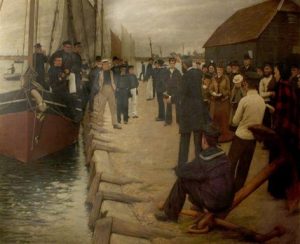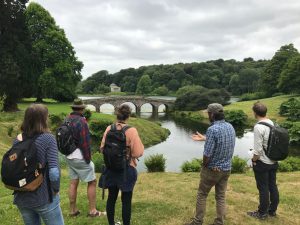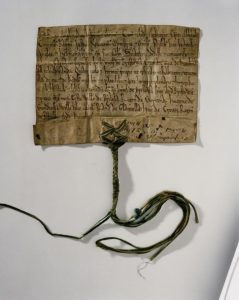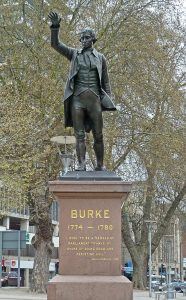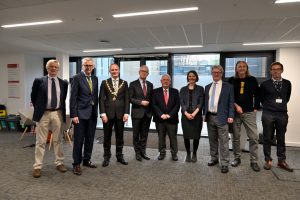
After four very happy and successful years as Dean of the Faculty of Arts, Professor Karla Pollmann will be leaving the University at the end of the summer to take up the post of President and Vice Chancellor at Tübingen University in her home town in Germany. We caught up with Karla to reflect upon her time in Bristol and wish her well in the new role.
In your first interview for the Faculty newsletter, you described Bristol as ‘vibrant, dynamic and forward-looking’. What would you now add to that list?
The descriptors I used then still all hold true! In a presentation at the most recent University Management Team (UMT) Residential meeting in September 2021, I further described Bristol and its fantastic University as:
- Open, friendly, individualistic
- Entrepreneurial, innovative, original
- Politically astute, educated workforce
- Adventurous, quirky.
Bristolians among the UMT and the Vice-Chancellor wholeheartedly agreed! ‘Quirky’ can be illustrated by a photograph I took last year which is telling testimony of the ability at Bristol to think in opposites:

What makes the University of Bristol – and the Faculty of Arts specifically – stand out for you?
First, as a comprehensive university Bristol boasts a great breadth of disciplines. This needs to be seen as an opportunity. The same holds true for the Faculty of Arts. This does not mean just continuing doing things the same way as before, but it opens up incredible new opportunities to work together across disciplines both in teaching and in research, something Bristol is already very good at and is excellently placed to do even more of. This is what the future needs, and so this will be a great service to society.
Second, the University is placed in one of the most beautiful cities on the planet, with a fantastic cultural programme, a vibrant creative sector and growing tech industry, and beautiful natural surroundings. The strong pulling-power of the city is of great benefit to the University, and vice versa.
Third and most importantly, its great people!
In 2019, you mentioned that your office was your favourite place on campus – has that changed?!
Well, I said this a bit tongue in cheek, as at that time – not long after my arrival – my office simply had been my main place of operation. Covid has changed this dramatically, so nearly half of my time as Dean was spent predominantly working from home, which came with its own benefits and challenges. But yes, I still think I have a great office (although at the moment it is in need of repair!). I also have fond memories of Café Nero where I regularly met up with colleagues for more informal chats, the restaurant at the Lido with its unique setting, and Bristol Zoo where we had an unforgettable Faculty Board Away Day and where our creative juices kept flowing, aided by a stimulating acoustic backdrop of roaring lions!
What are some of the achievements you are most proud of during your time as Dean?
That I instituted a Faculty IT Committee, which is seen by the University as state-of-the-art thanks to its fantastic members under the chair Gloria Visintini. Thank you!
That under my leadership we now have more female professors (nearly 50%) in Arts than ever before in the history of the University.
That we had a highly successful review of our marvellous Centre for Innovation and Entrepreneurship, which goes from strength to strength with winning awards and whose original and attention-grabbing designs range from Peequal to a cleaning case for reusable menstrual cups.
That we will get the Centre for Study Abroad, for which I have fought since my arrival and which will be a real game changer for the University and the Faculty.
That I managed to bring colleagues – both academic and professional services – together under our shared agenda to ensure that the Faculty of Arts is not seen as an optional extra, but is valued as an integral part of the University and its forward-looking strategy!
If someone asked you “Why do the Arts matter?”, what would your response be?
My general answer would be: because the future is walking towards the Arts. None of the great challenges that affect humankind as a whole can be solved without the Arts and Humanities.
On the one hand they can enrich a multidisciplinary agenda, for example in working with Engineering in relation to immersive technology and the creative sector. It needs to be emphasised over and over again that technological ‘progress’ as such is not an end in itself but needs to be assessed as to its social, cultural and legal consequences. Technology as such does not create content but is a vehicle for it. This is where the Arts and Humanities come to the fore.
On the other hand, therefore, the Arts and Humanities have a value in themselves which must not be overlooked or be obscured by dazzling technological changes. For instance, how we use language tells us a lot of how we think about nature, gender, or race. Ingrained habits of expression need to be critically reflected as an ongoing concern, also in exchange with other cultures and languages, in order to interrogate iteratively how we view the world and how we behave in it. This has massive consequences for society as a whole, and this is the distinctive and irreplaceable domain of the Arts and Humanities.
What are your wishes for the future of the Faculty of Arts?
The University of Bristol will from September onwards have a new VC, Professor Evelyn Welch, who is a distinguished Arts scholar in her own right and thus very familiar with the unique contribution of the Arts and Humanities. This means that on the one hand one cannot pull the wool over her eyes, but on the other she will see the great potential and specific contribution of our Faculty. I wish for the Faculty that it carries on with its agenda of growth through transformation; continues to have buoyant student recruitment – in particular international – in combination with exciting new programmes; continues to establish strong and successful cross-institutional research partnerships; and continues to make its presence and important contribution felt not only across the University but also to the benefit of the city, region, and wider society.
Are there any final thoughts you’d like to share with your Faculty colleagues?
I already know now that I will hold my four years at Bristol in my memory as some of the happiest years of my life. People are exceptionally friendly, thoughtful, intelligent and endearing in a way that was just perfect for me. I know this is not to be taken for granted. I also had the best job in the world, as being Dean opens up incredible creative opportunities. But I would not have got anywhere without the fantastic people, both academic staff and professional services, who supported me.
One of the distinctive features encapsulating all this is the graduation ceremonies which have been taken up again after a two-year break. In Germany, this tradition has been discontinued altogether since the 1960s – Tübingen has now asked whether I could reintroduce them! In these ceremonies the University celebrates an important rite of passage for its most precious asset, namely its students. Without our students, all the research we do and the values we hold would dry up as it will be the students who carry them out into the world. All this endeavour has got something fractured, unpredictable, and uncontrollable. Therefore, Matthew Brown and myself spent some delightful time before one graduation ceremony in July 2022 taking each other’s picture ‘through a glass darkly’.

I wish you all the very best for the future, and look forward to saying goodbye to as many of you as possible over the coming weeks!


